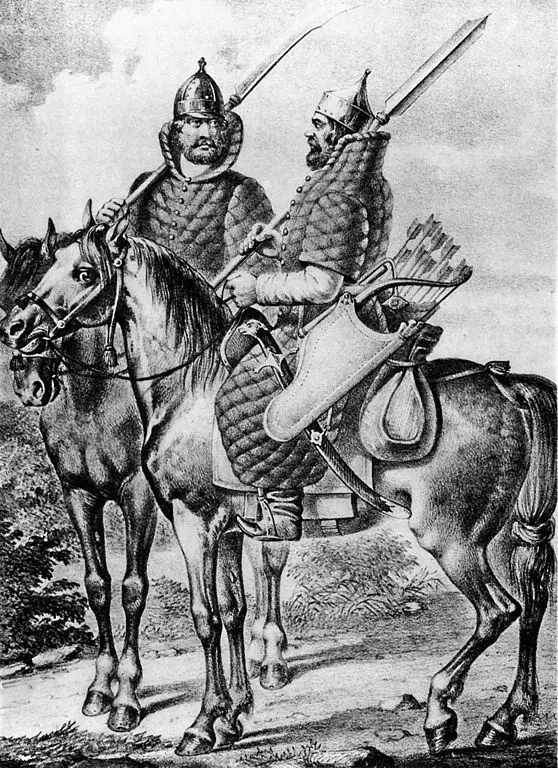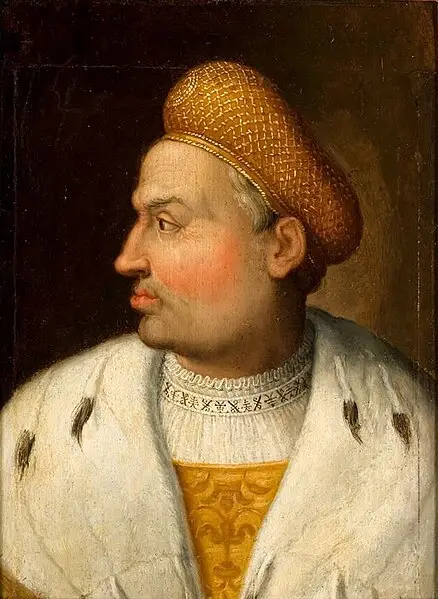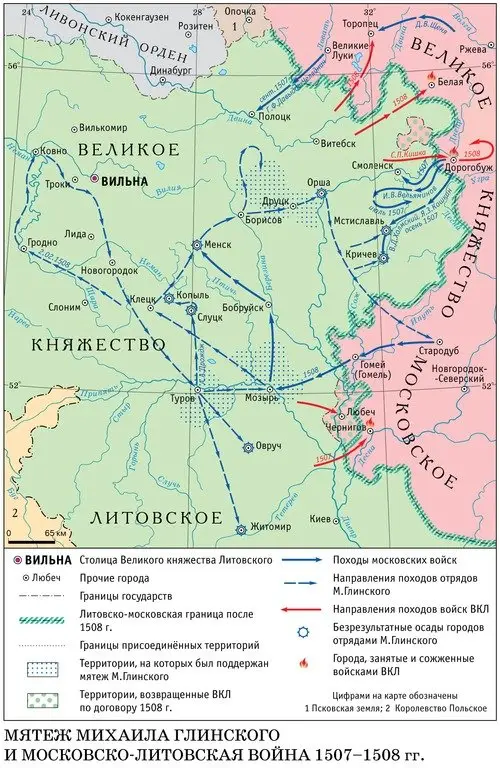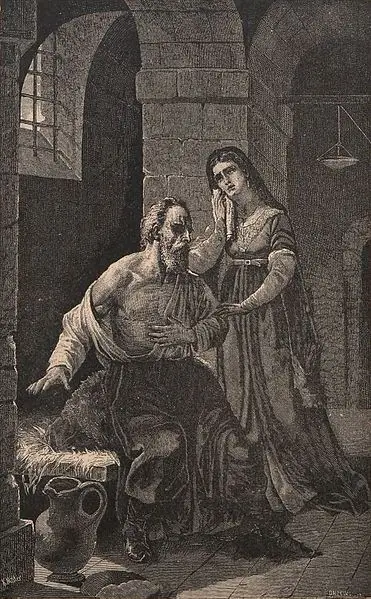Lithuania is trying to take revenge

Warriors in tags and iron caps. Historical description of clothing and weapons of the Russian troops, ed. A. V. Viskovatova, Part 1. St. Petersburg: Military. typ., 1841–1862
Threat of war on three fronts
After the death of Emperor Ivan III, the Lithuanian lords became bolder and decided to take revenge for their defeat in the war of 1500–1503, when Lithuania lost a third of its territory. The moment seemed favorable: Moscow was forced to fight with Kazan (Russian-Kazan War of 1505–1507). Kazan Khan Muhammad-Amina, on the wave of first successes, offers Lithuania an alliance against Moscow. Khan wanted to strike at the same time - in the spring of 1507.
At the same time, relations between Moscow and the Crimean Khanate deteriorated. The Crimean Khan Mengli-Girey appeals to the Polish king and the Grand Duke of Lithuania Alexander Kazimirovich with a proposal to begin joint military actions against the Russian state. The label of the Crimean Khan, sent to Vilna with the royal ambassador Yakub Ivashentsev, read: “In other words, against the Muscovite, against Ivanov’s son, at the same time with you, we want him to be an enemy.”
The Polish king Alexander Kazimirovich did not have time to take advantage of the advantageous situation and the difficult position of the new Russian sovereign Vasily III Ivanovich. On August 19, 1506 he died.
The brother of the deceased king and successor Sigismund I the Old (reigned 1506–1548) decided to implement plans for revenge. He received the nickname Old due to the fact that Sigismund became the Polish king and Grand Duke of Lithuania at a very mature age (born in 1467) after his two older brothers succeeded on the Polish throne. After Alexander’s funeral, he was elected Grand Duke of Lithuania on October 20, 1506, and then at the Petrokovsky Sejm on December 8, 1506 he was proclaimed King of Poland. Crowned in Krakow on January 24, 1507.
At the end of 1506, the Crimean oglan Tavakkul was present at the coronation of the Grand Duke of Lithuania Sigismund. In 1507, Pyotr Furs and Yakub Ivanshentsovich traveled to the Crimean Horde with embassies. Mengli-Girey issued a label to Sigismund I for “many Slavic lands,” in which he granted the Grand Duke significant territories that already belonged to the Grand Duke of Moscow, including Novgorod, Pskov, Ryazan, as well as the Seversky lands.
Sigismund enlisted the support of the Crimean Khan. Counting on the help of Kazan and deciding not to wait for the end of the Annunciation Truce of 1503, on February 2, 1507, he obtained from the Lithuanian Sejm a decision to start a war with Russia. The Lithuanian ambassador Soroka was sent to Kazan with a clear plan of action, which provided for a simultaneous attack on Rus' by Lithuanian, Crimean and Kazan troops.
An embassy was sent to Moscow led by Jan Radziwill and Bogdan Sopiezic. On behalf of the Polish king, it demanded the return of previously seized lands. Moreover, the Lithuanian lords laid claims even to Novgorod and Pskov - at this time the Novgorodians again remembered their freedom.
Lithuania's ultimatum did not frighten the Russian government.
During this period, Vasily Ivanovich negotiated with the Kazan Khan Muhammad-Amin, who came to his senses and was ready for peace. As a result, Moscow could transfer the liberated regiments from the eastern borders to the western borders. The Lithuanian ultimatum was rejected, war became inevitable.

Portrait of the Polish king Sigismund I. Attributed to Hans von Kulmbach. Between 1511 and 1518
War
In a letter from 20 in July 1507, King Sigismund informed the Crimean Khan Mengli-Giray about his campaign trip. Lithuanian troops were focused on three main areas. Detachments of Hetman Olbracht Hastold were assembled in Smolensk. The forces of Hetman Stanislav Glebovich are concentrated in Polotsk, and in Minsk the forces of the great Hetman Stanislav Kishka are concentrated. Lithuanian troops carried out a series of attacks on Russian lands, burned Chernihiv, ravaged the Bryansk land.
In response to these raids, two Russian armies set out on a campaign that same summer. Fyodor Petrovich Krivoy Sitsky fought on the southern Lithuanian border. And the army of Prince Ivan Mikhailovich Telyatevsky advanced from Dorogobuzh and acted in the Smolensk direction.
The Crimean Horde struck on the southern front in July. The Crimean Tatars attacked the Verkhovsky principalities, approached the cities of Belev, Odoev, Kozelsk, Kaluga, which diverted significant forces of Moscow to the south. Vasily III immediately moved his regiments south. Ivan Ivanovich Kholmsky moved towards the attacked Belev, and Konstantin Fedorovich Ushaty moved towards Kaluga. Local militia forces led by Vasily Odoevsky, Ivan Vorotynsky, and the Kozel governor Alexander Strigin also took part in the battles with the Crimean detachments.
The Russian forces were united into one fist and overtook the retreating enemy on the river. Oka. On August 9, 1507, the Crimean army suffered a heavy defeat and fled, the Tatars were pursued to the river. Rybnitsa, the right tributary of the Oka. After this defeat, the activity of the Crimean Horde resumed only in 1512. This was connected not only with the successful actions of the Russian governors, but also with the complication of Crimean-Nogai relations. The Crimean army, led by the khan’s eldest son, Mumammad-Girey, sent to the Russian borders, was turned against the Nogais.
Kazan Khan Muhammad-Amin made peace with the Moscow sovereign. Livonia, despite numerous invitations and requests from the Lithuanian side, decided to stay away from this war. As a result, the Principality of Lithuania was left without allies.
Having repelled the invasion of the Crimean troops, Russian troops again struck at the Lithuanian possessions. The Crimean Khan Mengli-Girey soon sent his envoy to Sigismund. He said that he was sending an ambassador to Moscow and invited the Lithuanian Grand Duke to do the same. Lithuania found itself in a difficult situation. On September 14, the Russian army under the command of Vasily Danilovich Kholmsky and Yakov Zakharyich began a campaign against Mstislavl. Krichev was also besieged. However, the Russian governors again failed to take Mstislavl.

Glinsky mutiny
The situation in the Grand Duchy of Lithuania and Russia was sharply aggravated by the rebellion of the Glinsky princes.
The Glinskys considered their family descended from Khan Mamai. The most prominent representative of this family was Prince Mikhail Lvovich Glinsky. He was born in 1470, had a remarkable mind, and lived for a long time in Western Europe. The prince was a knight of the German Empire, serving Elector (Prince) Albrecht of Saxony. He became a friend of Albrecht, acquired the friendship of princes, masters of knightly orders, bishops and cardinals. Then he served Emperor Maximilian, fought for him in Italy against the French, and there he converted to Catholicism.
Returning to his homeland in 1490, he became the largest and richest magnate, the closest adviser to King Alexander Jagiellon. Commander of the court guard and governor of Volsky. He in 1500–1506. held the important post of marshal of the courtyard. On August 6, 1506, the prince won a major victory over the forces of the Crimean Khan near Kletsk. The growth of his influence alarmed the old Lithuanian aristocracy: the Radziwills, the Kezgailovs, and especially Jan Zaberezinsky, who became the personal enemy of Mikhail Glinsky. The Lithuanian nobility feared that this adventurer could seize power into his own hands.
Being a confidant of the Grand Duke of Lithuania Alexander, Mikhail Glinsky contributed to the rise of his relatives, as well as his supporters, which further strengthened his position in Lithuania. It is likely that Prince Mikhail Glinsky decided to take advantage of the moment of change of power after the death of Alexander and create under his rule a separate Russian state with its capital in Kyiv. This state was supposed to include the eastern and southern lands of Lithuanian Rus.
Mikhail's enemy, the Grand Marshal of Lithuania Jan Zaberezinsky, accused Prince Glinsky of treason. He and his comrades sent news to the brother of the late king Sigismund that Prince Michael was seeking a great reign. Prince Mikhail recognized Sigismund as his true master. But after that he fell into disgrace. His demands regarding the start of the trial and investigation against Zaberezinsky did not find support from Sigismund.
Glinsky even turned to the Czech and Hungarian kings and the Crimean Khan for assistance. The Hungarian King Vladislav II sent ambassadors to the Grand Duke of Lithuania and the Polish King Sigismund with a request to give Glinsky “full satisfaction.” And the Crimean Khan Mengli-Girey sent a message demanding that Mikhail be reinstated as marshal. Sigismund took a number of measures directed against the Glinskys. At the beginning of 1507, the Kiev Voivodeship was taken away from Ivan Glinsky.
Mikhail did not wait for the Grand Duke’s further actions and rebelled. The prince began to spread rumors in the Grand Duchy that they were going to convert all Orthodox Christians to Catholicism, and those who refused would be executed, although he himself was a Catholic.
Taking advantage of King Sigismund's departure for the Diet in Krakow, Prince Glinsky gathered his relatives and supporters and announced to them his intentions. On February 2, 1508, Mikhail Glinsky with a detachment of 700 horsemen crossed the Neman River and surrounded the Zaberezinsky estate near Grodno. Glinsky’s friend, the German Schleinitz, burst into the estate with people - Zaberezinsky was killed.
After this, Glinsky made an attempt to take the Kovno castle, where the khan of the Great Horde Shikh-Akhmed (Sheikh-Akhmet) was kept, but the attack was repulsed. After the failure in Kovno, Glinsky’s detachment moved to Novogrudok, and then headed to Vilna. Mikhail Glinsky, having learned that the city was already ready for defense, passed it and returned to his residence Turov.
The Glinskys failed to rebel throughout Lithuanian Rus'. Most of the local magnates, Russian by origin, jealous of the wealth and power of the Glinskys, did not support the rebellion. They even rejoiced at the fall of the Glinskys. The Dnieper Cossacks did not support the rebellion either. Their chieftain was the Lithuanian aristocrat Landskoronsky. He was engaged in organizing the Cossacks to protect Southern Rus' from nomads.
And if Sigismund was betrayed by the Glinskys, then the Moscow sovereign Vasily was betrayed by Konstantin Ostrozhsky and Evstafiy Dashkovich. Ostorozhsky, a talented commander, was captured in the last war, but under the guarantee of the Metropolitan he took the oath and entered the service of the Russian Tsar. Dashkovich, the Lithuanian governor, voluntarily defected to the Moscow sovereign. Now both ran over to the Lithuanian prince. Sigismund received them well. Ostrozhsky was given Kyiv, Dashkovich - Kanev and Cherkassy, the centers of the Dnieper Cossacks. Dashkovich and Lyandskoronsky managed to keep the Dnieper region from uprising. They promised the Cossacks future favors from the king.
Moscow closely monitored developments in Lithuania and hastily sent a messenger, Dmitry Guba Moklokov, to Turov with an offer of military support. The Glinskys, realizing that the plan for a general rebellion of the Orthodox had failed, and their action would not be supported by other princes, turned to the Moscow sovereign, “so that the Grand Duke would favor them and take them into his service.”
At the same time, the Crimean ambassador Khozyash Mirza arrived at the Glinskys with an offer to go into the service of Khan Mengli-Girey, for which he promised the princes Kyiv and the surrounding territories. The Glinsky princes rejected this proposal.
The transfer of the Glinskys to the service of the Moscow sovereign Vasily III turned the rebellion from an internal affair of Lithuania into an episode of the Russian-Lithuanian War. Having sent the ambassador to Moscow and without waiting for the arrival of the Moscow army, the Glinsky detachment set out for Mozyr. The governor of Mozyr was Yakub Ivashentsev, being a cousin of Mikhail Glinsky, who surrendered the city without a fight. The youngest of the brothers, Vasily Glinsky, besieged Zhitomir and Ovruch at the end of March 1508. Prince Mikhail Glinsky himself captured Kletsk in April.

Mikhail Glinsky and his wife in prison. Polish lithograph 1901
Ending war
Trying to make the most of the current situation, the Moscow regiments went on the offensive along the entire front. On March 10, an army under the command of Yakov Zakharyich Koshkin set out on a campaign in the direction of Smolensk. The Novgorod army led by Daniil Vasilyevich Shchenya and Grigory Davydov came out from Velikie Luki to Polotsk. Both armies united near Orsha. The city was apparently re-fortified by the Lithuanians after the war of 1500–1503. In 1502 it was easily taken, this time the siege of the fortress dragged on.
In May, detachments of princes Vasily Shemyachich, Ivan Sukhoruk Odoevsky, Ivan Vorotynsky and Andrei Saburov advanced to the aid of Mikhail Glinsky, who besieged Minsk and Slutsk. Despite the support of Moscow troops, Glinsky failed to capture these cities. More successful was the campaign of Glinsky and Shemyachich against Drutsk. The garrison capitulated, and the Drutsk princes swore allegiance to Vasily Ivanovich.
The Glinsky rebellion and the siege of Orsha forced Sigismund I to take decisive steps. He assembled a large army, which, in addition to Lithuanian forces, included mercenary infantry. On July 13, the Lithuanian army approached the location of the Russian troops. Daniil Shchenya (Yakov Koshkin’s army stood near Dubrovna and could not support the main forces), uniting with the regiments of Glinsky and Shemyachich, on July 22, withdrew troops across the Dnieper to Dubrovna. The governors sent detachments to destroy the environs of Mstislavl and Krichev.
The Lithuanian army, under the leadership of Hetman Konstantin Ostrozhsky, who escaped from Russian captivity (he was captured in the Battle of Vedrosh on July 14, 1500), moved to the border and captured the cities of Belaya, Toropets and Dorogobuzh. But the Lithuanians were unable to gain a foothold in these cities. Tsar Vasily ordered Shchenya to return the cities captured by the Lithuanians.
At the beginning of September 1508, Russian troops drove the Lithuanians out of Toropets and occupied the burned Belaya and Dorogobuzh without a fight.
Eternal Peace
Despite some success achieved by Lithuanian troops in the Smolensk direction, Sigismund decided to begin peace negotiations. There was no help from the Crimean Horde; the Glinskys held a number of fortresses. There were no decisive successes at the front and no strength to turn the situation in their favor. On September 19, 1508, the Lithuanian embassy arrived in Moscow. Lithuania needed peace more, so Lithuanian representatives made a number of concessions.
On October 8, 1508, a peace treaty was signed.
Good neighborly relations were restored. The Grand Duchy of Lithuania recognized all the previous conquests of Moscow. In turn, Moscow agreed that the Glinsky lands remained part of Lithuania, and they had to move with their people and property to Muscovite Rus'. Lyubech remained with Lithuania.
At the end of 1508, Prince Mikhail Glinsky moved to Moscow, where he received Maloyaroslavets and Borovsk as his patrimony and Medyn was granted to Ivan.
The eternal peace lasted only until 1512, when the next Russian-Lithuanian war began.
Information